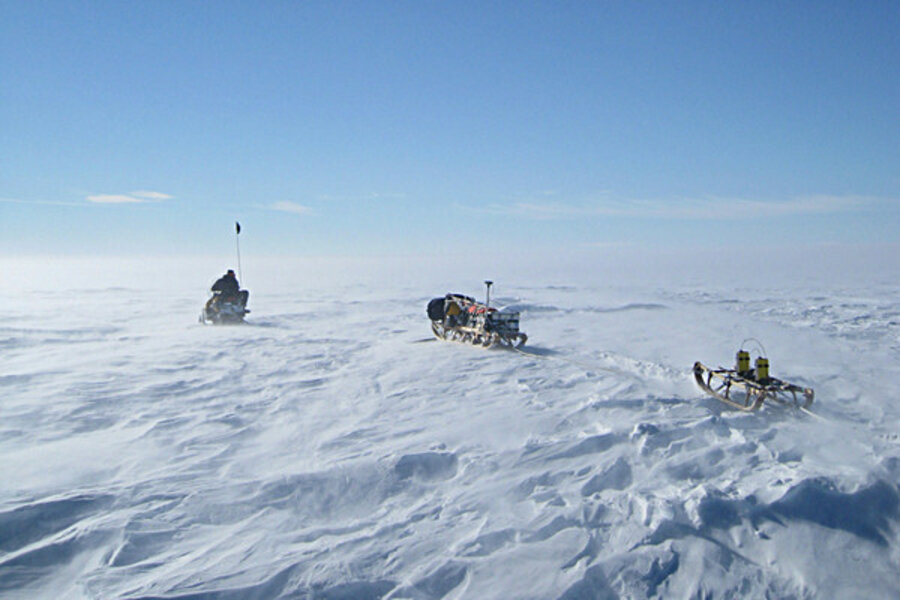Gigantic 'Grand Canyon' buried beneath Antarctic ice
A dramatic gash in the surface of the Earth that could rival the majesty of the Grand Canyon has been discovered secreted beneath Antarctica's vast, featureless ice sheet.
Dubbed the Ferrigno Rift for the glacier that fills it, the chasm's steep walls plunge nearly a mile down (1.5 kilometers) at its deepest. It is roughly 6 miles (10 km) across and at least 62 miles (100 km) long, possibly far longer if it extends into the sea.
The rift was discovered during a grueling 1,500-mile (2,400 km) trek that, save for a few modern conveniences, hearkens back to the days of early Antarctic exploration. And it came as a total surprise, according to the man who first sensed that something incredible was literally underfoot, hidden by more than a half-mile (1 km) of ice.
Old-school exploration
Robert Bingham, a glaciologist at the University of Aberdeen, along with field assistant Chris Griffiths, had embarked on a nine-week trip during the 2009-2010 field season to survey the Ferrigno Glacier, a region humans had visited only once before, 50 years earlier. Over the last decade, satellites have revealed the glacier is the site of the most dramatic ice loss in its West Antarctica neighborhood, a fringe of coastline just west of the Antarctic Peninsula — the narrow finger of land that points toward South America.
The two-man team set out aboard snowmobiles, dragging radar equipment behind them to measure the topography of the rock beneath the windswept ice, in a region notorious for atrocious weather. Braced for arduous, yet uneventful fieldwork, the surprise came right away. [Images: Antarctica's Icy Wilderness]
"It was literally one of the first days that we were driving across the ice stream, doing what we thought was a pretty standard survey, that I saw the bed of the ice just dropping away," Bingham said.
The drop was so sudden and so deep that Bingham drove back and forth across the area two or three more times to check the data, and saw the same pattern. "We got the sense that there was something really exciting under there," he told OurAmazingPlanet. "It was one of the most exciting science missions I've ever had."
Slippery implications
Bingham compared the hidden chasm to the Grand Canyon in scale, but said that tectonic forces of continental rifting — in contrast to erosion — created the Ferrigno Rift, wrenching the fissure's walls apart probably tens of millions of years ago, when Antarctica was ice-free.
Excitement surrounding the discovery has deeper implications than the mere gee-whiz factor of finding such a massive feature. The Ferrigno Rift's "existence profoundly affects ice loss," Bingham and co-authors from the British Antarctic Survey wrote in a paper published in Nature today (July 25).
"The geology and topography under the ice controls how the ice flows," said Robin Bell, a geophysicist and professor at Columbia University's Lamont-Doherty Earth Observatory, who was not associated with the research. "Ice will flow faster over sediments, like those found in rifts," said Bell, a veteran Antarctic researcher, who has long studied yet another dramatic, yet invisible geological feature, the hidden Gamburtsev Mountains in East Antarctica.
In addition, the study authors write, the rift is providing a channel for warm ocean water to creep toward the interior of the West Antarctic Ice Sheet, gnawing away at the Ferrigno Glacier from below.
Together, these two factors could be speeding the glacier's march to the sea, and the overall effects could have implications for the stability of the West Antarctic Ice Sheet, which is responsible for 10 percent of global sea level rise that is currently happening.
Scientists are still only just beginning to understand the myriad mechanisms that control the seemingly dramatic melting observed in regions of West Antarctica, and how climate change is affecting all the moving parts.
"With something like the Antarctic ice sheet, some of these processes take centuries, and the amount of time we've been able to observe changes is at the maximum 20 years," Bingham said. "It's a very small amount of time."
"We need to gather more data," he said.
Reach Andrea Mustain at amustain@techmedianetwork.com, or follow her on Twitter @AndreaMustain. Follow OurAmazingPlanet on Twitter @OAPlanet. We're also on Facebook & Google+.
- Images: The Majestic Transantarctic Mountains
- Video - Antarctica: Solving Geologic Mysteries
- Infographic: Antarctica – 100 Years of Exploration
Copyright 2012 OurAmazingPlanet, a TechMediaNetwork company. All rights reserved. This material may not be published, broadcast, rewritten or redistributed.






